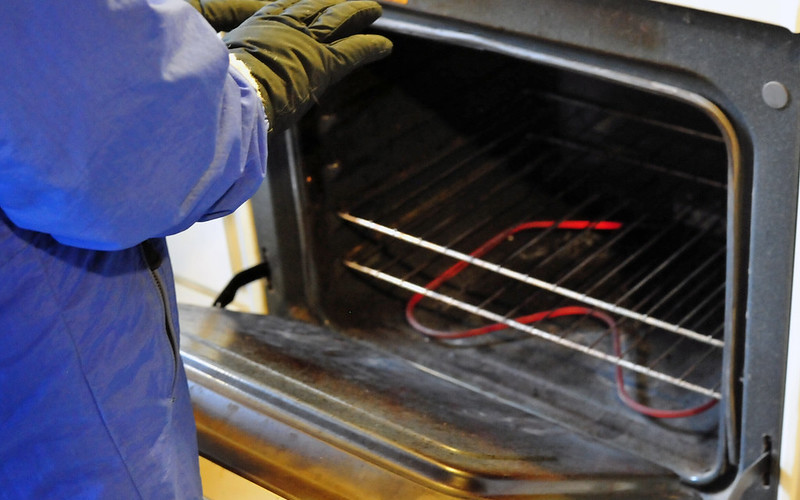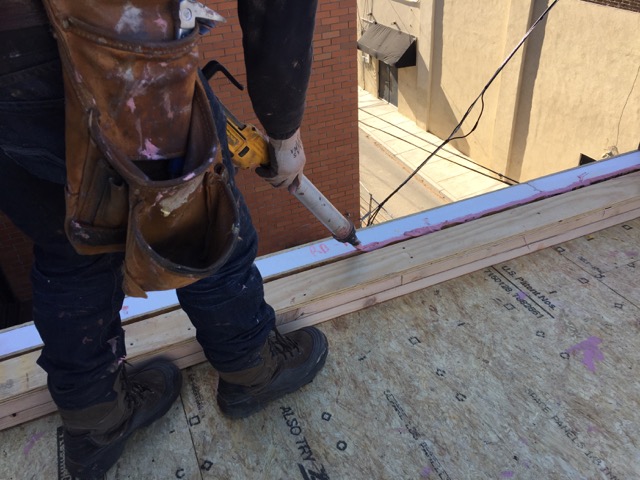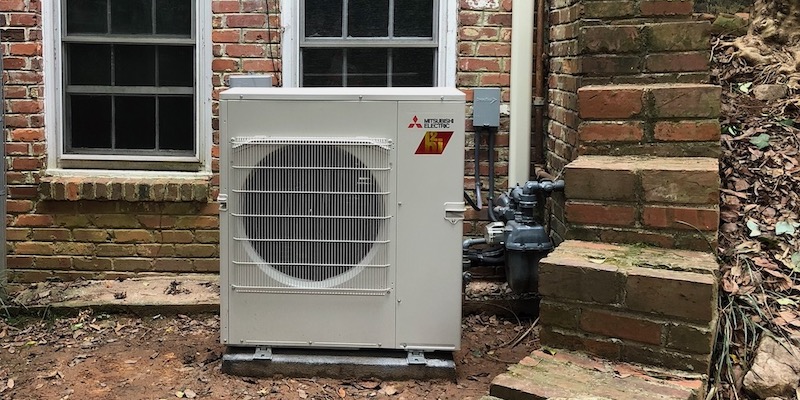Heat Pumps, Auxiliary Heat, and Resilience

What happened in Texas this winter has a lot of people thinking about our dependence on electricity and what happens when the power goes out in extreme weather. Recently I wrote about Gary Nelson’s house in Minneapolis that’s heated by a heat pump with no auxiliary heat. That spurred this comment from reader Rich Lovoie:
Heat pumps are great, I have 2 in my house, I use them to avoid using my oil heating system in mild weather. However, as an HVAC contractor, I also know how sophisticated heat pumps can be, and how unskilled most HVAC techs are. This is particularly true when it comes to “ductless” type heat pumps as they are the most complex to troubleshoot. Imagine a failure of your super efficient HP at -27 degrees, you think an HVAC tech is going stand in the cold, wind, snow, dark, and figure it out?
Should we be afraid of relying on heat pumps in our homes? Let’s take a look at the solutions.
Resilience begins with the building enclosure
If you live in a place that can get perilously cold—and we know now that includes places like Texas—a house that holds onto its heat should be your first defense. That means airtightness, insulation, good windows, and little to no duct losses. Gary Nelson’s home is extremely airtight at 1 air change per hour at 50 Pascals. His walls are insulated to R-30 to R-40, the ceiling is R-50, and the windows are triple-pane, argon-filled, with low-e coatings on three surfaces.
Gary told me, “In an extended power outage the high performance envelope would probably make it pretty easy to live in the house for at least a couple days and I think would prevent the pipes from ever freezing.” He also found that the basement stayed warmer than the upstairs, so he could always close the basement door and stay down there longer. And the warmer and sunnier it is outdoors during the power outage, the longer he can stay in the house. That’s resilience!

Lloyd Alter at Treehugger wrote an excellent article on this topic after the Texas disaster. Titled Why Every Home Should Be a Thermal Battery, one important point he mentioned was Alex Wilson’s writing on resilience ten years ago. Wilson made the connection between resilience and the energy efficiency we’ve been promoting for decades. The most important thing we can do is to transform our builds so they can “maintain livable conditions in the event of extended power outages or interruptions in heating fuel.” And the best way to do that is with robust building enclosures that are airtight and have high insulation levels. You know, like Passive House.
Alter also covered an interesting phenomenon that occurred during the Texas power outage. Mark Siddall, an architect in the UK, started what became hashtagged on Twitter as the #PassivhausChallenge, a period during which Passive House occupants voluntarily turned off their heat pumps and monitored the temperature inside their homes to see just how resilient they were. Alter’s article was written in the middle of the challenge, and most of the examples he included were for homes where the outdoor temperatures were above freezing. Here’s a nice below-freezing result I found in the #PassivhausChallenge search results:
#PassivhausChallenge heats been off since Feb 11th, temp no lower than 62f inside, 10f outside
— David Hill (@DavidHi12070892) February 20, 2021
Resilience starts with the building enclosure and makes living with heat pumps in cold climates much easier. But that doesn’t mean they can’t be used in anything but a super-airtight, super-insulated house.
What happens when the heat pump stops pumping heat?
Lovoie, an HVAC contractor, naturally worries about having to make a service call in extreme weather. In Nelson’s case, he wouldn’t need someone to service the system immediately. As previously mentioned, his house would remain livable for at least a couple of days without any heat. If he still had electricity, the four 1,500 watt space heaters would cover more than his design heating load, if he wanted to heat the whole house. And he’s always got the electric oven!
I live in an all-electric, not super-airtight, not super-insulated home. We had the gas meter removed in November 2019 after I installed a Mitsubishi mini-split heat pump with two ducted air handlers. With a winter design temperature of 23° F, Atlanta does get cold sometimes, although we were spared the storm that tanked Texas in February. Like Gary Nelson, I also have no auxiliary heat in my system. What would I do if the heat pump stopped working during a cold spell?
After installing the heat pump that heats most of our main floor, I had a ductless unit installed in the sunroom. If the main unit stopped working, we could always close the doors and hang out in the sunroom to stay warm until the other heat pump got repaired. This kind of redundancy serves as a good backup. And it’s another reason to install one-to-one mini-split heat pumps instead of multiple indoor units running on one outdoor unit.

Speaking of one-to-one mini-splits, at the time I got our main heat pump, Mitsubishi didn’t yet have outdoor units with Hyper-Heat for one-to-one setups . Now they do, so maybe someday when I have some extra money, I’ll replace the one outdoor unit with two. That would help with the view from the windows in that basement bedroom, too. (See photo above.)
The answer: resilience and redundancy
Ideally, every home would be resilient enough to get through extreme weather events, survive equipment failures, and get through power outages. That starts with the building enclosure. Seal it up. Insulate it as much as you can. And don’t forget ventilation!
Beyond the building enclosure, think through your heating and cooling sources. Auxiliary heat doesn’t have to be built into the heating system. Gary Nelson proved that. Multiple heat pumps can help with mechanical failure of one. And one-to-one mini-splits rather than multi-splits provide a safety factor, too.
We really do have the know-how and the technology to make all-electric homes work, even in cold climates. We can get fossil fuels out of homes now.
Allison Bailes of Atlanta, Georgia, is a speaker, writer, building science consultant, and founder of Energy Vanguard. He is also the author of the Energy Vanguard Blog and is writing a book. You can follow him on Twitter at @EnergyVanguard.
Related Articles
Can a Heat Pump Work in Minnesota?
My Undersized Ducted Mini-Split Heat Pump
The 3 Types of Heat From Heat Pumps
The #1 Reason to Have an All-Electric Home
Photo of heating with oven by State Farm from flickr.com, used under a Creative Commons license
NOTE: Comments are moderated. Your comment will not appear below until approved.
This Post Has 15 Comments
Comments are closed.

A house that tite is not healthy you need to bring in outside air and then you loose your inside heat so what are you talking about the titer the house the better I don’t think so
Ralph, you are in luck! I’m writing a book just for you to dispel that kind of antiquated and incorrect thinking about air leakage. Here’s the title and link to my page about it:
A House Needs to Breathe…Or Does It?
Isn’t that a gas meter next to outdoor unit?
You do need erv with a house that tight between $3000 and $4000. We’ve incorporated co2 sensors to monitor the indoor air and turn on erv.
Slumpbrick, yes, that’s the gas meter that was at our house when we bought it. Not long after I took that photo, we started up the new heat pump and had the gas company remove the meter.
The super insulated, super sealed building sounds great, but how does that play with the reality of opening doors multiple times throughout the day? As of 10am today, between letting the cat, dog, and kids in or out, I think we’ve opened the doors about 10 or 12 times.
Jamie, air-sealing always gets good marks on “plays very well others.” Yes, you get some air exchange when you open doors, but you’ve eliminated the “doors” that were open 24/7/365.
When electric power is down for a week, an increasingly probable scenario due to increasing intensity of storms caused by climate change, how can electricity be used as a “backup” in whatever form? You severed yourself from the natural gas line just at the time it has grown in importance, since gas lines are run underground. I am thinking about this because I am planning on installing a Bosch 18 .5 SEER heat pump package unit to replace our failed gas pack, and have decided not to buy it with an electric emergency heat strip, so have more than a little concern over cutting our gas line. We live in central North Carolina, and made it through the winter without our gas furnace using 4 1.5Kw space heaters. And that is without doing all the work I plan for sealing, insulating, etc.
Bill, your building enclosure improvements can do the heavy lifting for your emergency heat planning. The auxiliary heat for an air source heat pump is used mainly for supplemented the compressor heat when it’s really cold outdoors. When your heat pump fails, that auxiliary heat can become your emergency heat. I didn’t mention it in the article, but another part of the solution for an all-electric home can be storage.
Bill wrote: “…just at the time (natural gas) has grown in importance, since gas lines are run underground
It’s true that natural gas service is generally more robust than the electric grid during wind or ice storms, but as we saw this year in Texas, gas distribution is by no means guaranteed. Although I don’t have natural gas service, I’m aware that gas distribution was interrupted in my region (SE Arizona) for multiple days during winter in recent years.
One advantage that heat pumps have over gas heat is that they can operate on a generator (you need a generator anyway to operate a gas furnace when the power is down). I used to live in Charlotte where ice storms were a common occurrence. I could easily keep my passive solar house comfy during an extended outage with a 6kW gasoline generator (http://veryuniquehome.com). Rather than dedicate specific circuits to the genset, I installed a (manual) transfer switch that back-fed power to the whole house. I just had to manage the largest loads when operating on generator power, e.g., disable heat pump when I needed to energize the water heater.
Today’s multi-stage or variable heat pumps could operate on a much smaller genset due to the ultra-low start-up current. Also, a diesel generator would be more convenient since diesel can be more readily stored on site.
Solar power with battery backup is becoming more feasible now that hybrid inverters are available that operate on- or off-grid. But this approach to resilience is still considerably more expensive than a generator backup system per kW capacity.
Lastly, for new construction, you can’t beat classic passive solar design in terms of cold weather resilience. Unfortunately, it’s fallen out of favor in recent years.
A system comprised of 2 or 3 (smaller) single-splits is not only more resilient (than a multi-split system), it’s more efficient and often costs less.
As one of the millions of Central Texans who spent a week iced in at home, a backup propane generator and lp furnace would have be a great addition to our 35 year old heat pump house. While not advertised, we do see ice and snow every few years but not for seven days at a time. In 2018 it was three days in our very hilly countryside. Many millions had no electricity or water for days on end. Most had rolling outages. While passive house construction would solve the thermal problem, what is the solution for the other 29 million Texans that don’t have that luxury? Certainly more secure powerplants and interconnected grids would be a start. Traditionally the solution was residential fireplaces, while theoretically inefficient, they did save the day for many this year.
While it isn’t a popular thing in the minds of some, we install gas or propane fireplaces in our houses. Realistically, they rarely get used as we install VRFs standard in our homes, and we standard make our houses generator ready. However, I like the idea of a homeowner not having to one hundred percent rely on a generator or grid electric for those times of extreme weather conditions.
Building in resiliency and simultaneously going all electric is quite the challenge. Given the ridiculous cost of backup batteries that would only be useful to me in extreme cases (since we have no time of use electric charges and a 1:1 purchase power agreement with our electric utility for our solar PV that effectively allows me to use the grid as our battery) I’m holding out for the day when I can utilize the 40 kW battery under the hood of our new electric car to power my house in an outage. To me this seems a much more appropriate use of batteries, but I have to admit that draining the battery of our possible escape route in an emergency also presents a new challenge.
Why ignore ground source heat pumps? Not only can they operate well below zero, their efficiency and capacity hardly drops at all during cold snaps and they do not need supplemental heat if installed in a high performance building. If one is trying to achieve zero net energy then GSHPs are cheaper to install because they use less than 1/2 the electricity a quality ASHP uses in northern climates. They do not need supplemental heat in most cases. If one is trying to achieve zero net energy then they can be cheaper to install because of their significantly lower use of electricity.
They are also much easier to repair, even in really bad weather because they are entirely inside the house (other than the ground loop, which is under the ground.)
My concern is the cost of making a 1961 house airtight vs having a second natural gas emergency heat source. I live in Wisconsin, near Milwaukee, and we get cold weather. I think the cost of converting to heat pumps and making the house airtight would be prohibitive. Escpecially since I’m retired on a fixed income and not a handyman.
When I lived in California my house had a Williams gravity wall furnace. No electricity required. I was thinking of having one installed in my basement so in case of a power outage I could keep my pipes from freezing and even live in the basement for a few days.